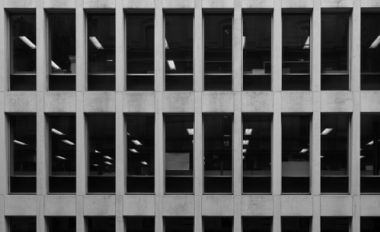You can download The Case for Good Design - Healthcare here or read the full text below.
We cannot afford not to invest in good design. Good design is not just about the aesthetic improvement of our environment, it is as much about improved quality of life, equality of opportunity and economic growth.
Executive summary
Our everyday lives are touched by the places that surround us. The qualities of these places – our buildings, streets and parks – informs our interactions, understandings, wellbeing and memories. A review of research exploring healthcare, education, workplaces, housing, justice, urban design and transport projects demonstrates that good design enables people, places and the environment to thrive.
A great building must begin with the unmeasurable, must go through measurable means when it is being designed and in the end must be unmeasurable.
What is good design?
‘What is good design? It’s a seemingly simple question that’s surprisingly difficult to answer. The more you think about it, the more complex the question becomes. Not only does “good design” mean different things to different people, it also changes at different times and in different contexts.’1
Good design comes in many forms and is defined by much more than how something looks. It refines the purpose and aspiration of a project, improves how it works, creates additional benefits and elevates how people feel and behave in the final outcome. Good design creates inspiring places and greater, lasting financial value. And of course, good design also looks and feels good.
Measuring the impact of design
There is extensive academic and scientific research that explores the benefits of well-designed places, and the effect of poor design on our lives. This research demonstrates that good design has far-reaching benefits, such as supporting health and wellbeing, improving environmental quality and improving productivity. As links between design and neuroscience, health and human behaviour continue to emerge, it is important that this evidence-base informs decision making about the shape, nature and function of our cities, buildings and landscapes.
Making the case
It has been demonstrated that ‘Good design does not cost more when measured across the lifetime of the building or place.’2 Investments in the design of our built environment have a lasting legacy on their place and the people who visit. Yet design is often considered a superficial afterthought.
Good design may cost more in the short term, but this investment is generally paid off over the lifetime of the building or place. Construction costs are typically 2–3 per cent of the whole-life costs, while operating costs are estimated to be 85 per cent. In comparison, design costs are small, between 0.3–0.5 per cent, yet they can significantly affect the function of a project across its lifespan, and the operating costs associated with this.3
The research demonstrates a host of benefits of good design, including:
- Well-designed hospitals help patients heal faster, support staff performance, recruitment and retention, and reduce operating costs.
- Well-designed schools improve student performance, and support staff performance, recruitment and retention.
- Well-designed police stations, courts and prisons help foster fairness and reduce recidivism in our justice system.
- Well-designed workplaces support productivity.
- Well-designed housing creates a greater sense of community and reduces ongoing costs.
- Well-designed urban spaces improve wellbeing and social connectedness.
- Well-designed transport systems boost productivity, reduce congestion and pollution.
This report is an overview of the research on the impact of the design of our surroundings. It is hoped that the findings generate conversations about the importance of embedding design quality in every stage of a project’s lifecycle and inform decision-making about our built environment. It may also encourage others to share the evidence they have uncovered and influence researchers to investigate gaps.
Supported by this evolving evidence, quality design is at the heart of a successful place – it is not an optional extra. Quality design ensures a positive legacy to become the heritage of the future.

Healthcare
A hospital is the site of some of our best and worst life experiences, the site of birth and death, healing and loss. Of all public buildings, they should be the ones that are built with the greatest care and imagination.4
We feel a spectrum of emotions in healthcare settings, experiencing joy, fear and sorrow in places of birth, care, recovery and death. As important places that support us through some of our best and worst life experiences, healthcare settings need to be designed with empathy and creativity.
Good design adds the most value to healthcare projects when there is understanding of the needs of the patient, as well as their loved ones and the staff.
There is strong evidence that well-designed healthcare facilities have measurable positive outcomes, helping patients to recover sooner, improving patient and visitor experiences, and increasing staff effectiveness in their care.5
More than 1,200 studies demonstrate that good design qualities integrated in hospitals improve patient’s health outcomes and experiences and support staff performance.6 This research finds that a range of good design qualities, including access to natural light, fresh air, views to nature, quietness, private rooms, clear wayfinding, and a sense of place, improve health outcomes as well as the operation of healthcare facilities.
These design qualities are linked with reducing the amount of time patients spend in hospital, improving sleep, reducing pain, stress and the need for medication, and minimising medical errors. Embedding principles of good design in the master planning and design of healthcare facilities contributes to the quality of care and experience of patients, as well as improving the efficiency of services.
+1200 studies demonstrate the links between design and health outcomes.7
Measuring good design
Hospitals collect a great deal of data, including a patient’s length of stay, the amount of medicine they require and observations of their condition and behaviour. Hospital performance is regularly measured through data about clinical processes and outcomes, quality and operating costs of hospital services and patient experiences. Many studies of the design of healthcare facilities use this data to explore the effects of the physical environment. Evidence-based design processes use credible research to make decisions about the design of the built environment in order to achieve the best possible outcomes for patients visitors and staff.10
90% of medical staff believe good design is linked to patient recovery.8
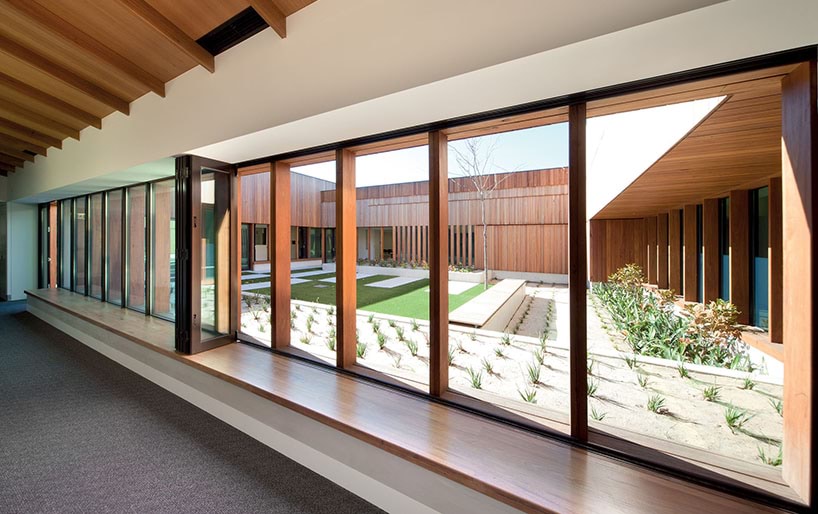
Creating the business case
Implementing good design principles does not necessarily cost more, and indeed, it has potential to save money through improved efficiency of care. Evidence shows that good design contributes to clinical outcomes through reduced patient stays in hospital, medication, infection rates and medical errors. It also supports staff attraction, retention and performance 11 and represents significant cost savings. Poorly designed health facilities increase danger and risk.
To estimate the economic impact of best-practice design, an imaginary hospital, the ‘Fable Hospital’, was conceived as an amalgam of the best design innovations implemented and measured by leading hospitals. The analysis showed that although design innovations may cost more initially as part of the building cost (calculated at 5 per cent of total construction costs), they offered a return on investment within one year by reducing operating costs and increasing revenue.12 ‘Fable 2.0’, a follow-up analysis, incorporated additional evidence-based design features amounting to approximately 7–8 per cent of total construction costs, and was found to have a payback within three years.13
Benefits of good design
There is strong evidence that good design of healthcare facilities helps to:
- Reduce patient recovery times and length of hospital stays.
- Reduce patient levels of pain and need for medication.
- Reduce patient behavioural issues.
- Improve patient experiences and satisfaction.
- Reduce patient, staff and visitor stress.
- Improve staff attraction, performance, morale and retention.
- Reduce medical errors and improve patient safety.
- Reduce operational costs, improve efficiency and save money.
Not only is there a very large body of evidence to guide hospital design, but a very strong one. A growing scientific literature is confirming that the conventional ways that hospitals are designed contributes to stress and danger, or more positively, that this level of risk and stress is unnecessary: improved physical settings can be an important tool in making hospitals safer, more healing, and better places to work.’9
Impact of good design - key findings
A study of two hospitals in the UK found that patients who were treated in refurbished wards spent less time in hospital, required less pain medication and were calmer compared with those recovering in older, conventional-style wards.15 This research demonstrates the significant effect that the design of the physical environment has on patient wellbeing and recovery, as well as on staff experiences and cost savings for hospitals.
Recovery 4–21% less time spent in an upgraded hospital.14
The study found patients at Poole Hospital spent 21 per cent less time in hospital and required less pain medication when treated in a refurbished ward compared with those in a conventional 1960s ward.16 Patients treated in a purpose-built psychiatric facility at South Downs Health spent an average of 14 per cent less time in hospital and there were fewer behavioural incidents compared with patients in older wards.17 Patients in newer wards gave higher ratings to their medical treatment, even though in many cases they were treated by the same people as those in the older wards. They also reported higher levels of satisfaction with their surroundings, rating the appearance, overall design and spatial organisation higher compared with those in the older wards.
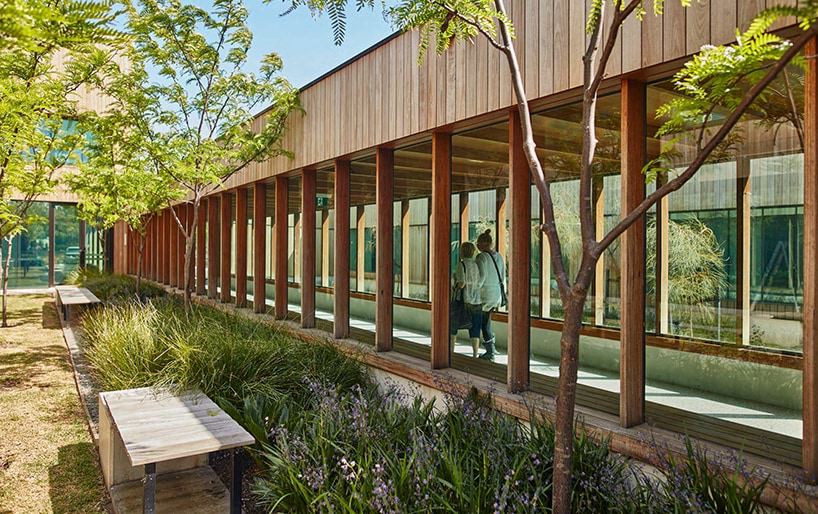
Workplace 29% of time is spent walking or in transit by nurses.18
Studies link hospital design with staff attraction, morale, retention, and performance.19 A survey of 479 nurses found that the quality of internal and external spaces is perceived to play an important role in staff recruitment, retention and performance.20 The design and layout of the wards has been found to affect the amount of time nurses spend walking and in transit. One study estimated nurses spend up to a third of their time walking around the ward.21 This finding highlights the importance of considering ward layouts and hospital master plans to enable staff to optimise their time and improve their efficiency in caring for patients.
Wayfinding - $220,000 per year for poor wayfinding.22
Poor wayfinding in hospitals is disorienting for patients and visitors, causing unnecessary stress.23 Poor wayfinding was found to cost a major regional 604-bed hospital more than $220,000 per year, or $448 per bed. Over the course of a year, 4,500 staff hours, or the equivalent of two full-time staff, were spent providing directions.24 This shows the importance of taking an integrated and coordinated approach to the siting of buildings and their internal layouts in order to support logical and clear navigation.
Views to nature - 1 day less spent in hospital in a room with a view of nature.25
Access to or a view of nature helps to reduce stress and pain and speeds recovery for patients.26 A study found that patients with a view of nature were discharged almost one day earlier from hospital than patients facing a brick wall.27 Patients with the view of nature also required less medication and nurses noted they had more positive comments in relation to their wellbeing and experience.28
Landscape - 78% felt more relaxed and calmer from visiting the hospital garden.29
Gardens provide restorative and calming places that help reduce stress and provide respite from the clinical setting.30 A key design intent of the Maggie Cancer Centres in the UK and Hong Kong is the use of landscape for healing. Maggie Centres offer support to cancer sufferers and their relatives. A research project explored the qualities, patterns of activity and people’s experiences at four hospital gardens in the San Francisco Bay area. Of the 143 people who were interviewed about their perspectives, 78 per cent described feeling more relaxed, less stressed, calmer and contented after spending time in the garden.31
Natural light - 13-30% less time spent in hospital in a sunny room.32
There is evidence that exposure to natural light while recovering in hospital aids recovery. Several studies have compared the recovery of psychiatric and heart-attack patients in sunny and dull rooms. They found that patients in the sunnier rooms recovered sooner, spending on average 13–30 per cent less time in hospital.33 The study of heart-attack patients found that the mortality rate was 4 per cent higher for those treated in the dull rooms compared with those in the sunny rooms.
22% less medication for patients with increased levels of sunlight.34
Another study found patients undergoing surgery who were exposed to an increased level of sunlight in their room experienced lower levels of stress and pain, required 22 per cent less pain medication per hour and had 21 per cent lower pain medication costs compared with those in duller rooms.35 These findings have significant implications for reducing patient suffering, improving efficiency of treatment and reducing healthcare costs through optimal siting and orientation of hospital buildings for sunlight.
Air quality
Good design practice not only affects things you can see, like views and materials, but the unseen ‘dark matter’ of building servicing systems, such as the air occupants breathe. Research highlights good air quality helps to protect patients from the spread of airborne diseases and reduces infection rates within the hospital.36 A number of measures, including type of air filtration, airflow direction, air pressure, air changes per hour, humidity and ventilation system and maintenance are linked with reducing infection rates.37 The need to create medically sealed and controlled environments is well known. An operating theatre cannot have openable windows, but hospitals contain diverse spaces. There is a strong perception that connected, centralised hospital air systems can make you sick, and that poorly managed or maintained systems can contribute to the spread of illness.38
Private rooms - 50% decreased rate of infection in intensive care unit with private rooms.39
Thirty per cent of patients in intensive care units acquire infections while in hospital, leading to illness and fatalities.40 These infections are associated with an increased length of stay up to nine days in intensive care.41 This additional time in hospital contributes a significant cost to society.42 A study found a significant reduction in patient infections for intensive care unit patients in single-bed rooms compared with shared rooms. A five-year study of more than 19,000 patient admissions to two hospitals in Montreal found that the rate of bacterial infections decreased by more than 50 per cent when shared rooms in the intensive care units were redesigned as private rooms.43 The study also found that private rooms reduced the length of stay by 10 per cent.44 Studies indicate other benefits of single-bed rooms, including a greater level of privacy and reduced medical errors.45
Noise
Patients recover faster in quieter environments where they are able to rest and sleep without disturbance. Noise levels also affect staff stress levels.
The Royal Children's Hospital - A hospital in the park
Architect: Billard Leece Partnership and Bates Smart
Landscape Architect: Land Design Partnership
Year: 2011
Cost: $1 billion
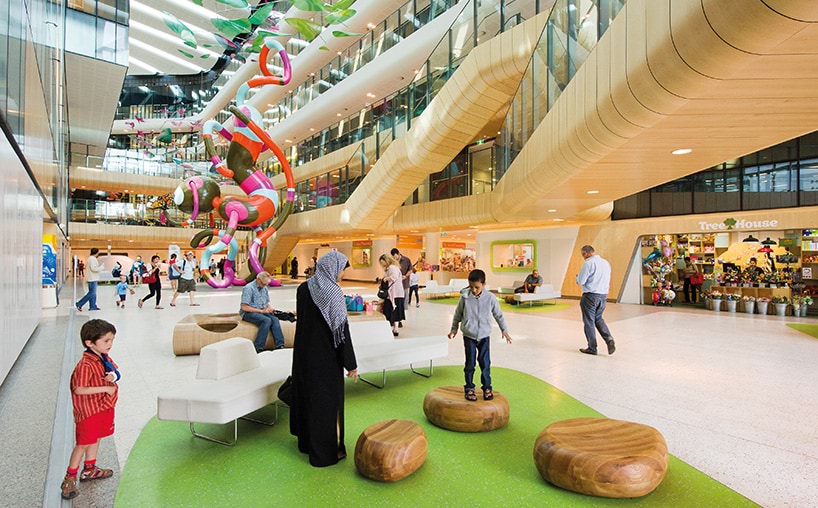
The Royal Children’s Hospital is designed to provide a healing environment to assist children with recovery. Replacing the original hermetically sealed building of 1963 that had little relationship to the surrounding Royal Park, the hospital design is based on a care model that places children and their families at the centre. Comprising 357 beds across seven levels, the hospital creates a welcoming and restorative environment by prioritising human values and experience. A generous internal thoroughfare at ground floor is designed as a ‘main street’ to help guide visitors, and provide spaces to capture children’s interest, such as an aquarium, sculptures and interactive screens. The hospital is designed to improve the experience of patients, visitors and staffs by providing strong visual and physical connections to the surrounding landscape, bringing in natural light and fresh air, and creating spaces that do not feel institutional.
Connecting with nature
Envisaged as a ‘hospital in a park’, with strong connections to Royal Park, the design reflects the therapeutic benefits of access to nature for healing.46 The star-shaped footprint of the wards extends into the surrounding parkland and creates a series of internal courtyards. This maximises children’s views to Royal Park to foster a connection with nature and a view to the outside, providing visual delight and a potential distraction. Eighty per cent of patient rooms and all-day medical chairs benefit from overlooking and views of Royal Park, and the remaining 20 per cent of patient rooms have a view to courtyards or gardens.47 Windows along the circulation spine enable views to the gardens and city skyline, helping with intuitive wayfinding for visitors.48
An inviting place
The design embraces the notion of a park within a hospital to create a playful and calming environment for children, visitors and staff. A two-storey aquarium is visible from the foyer and emergency department and a meerkat enclosure developed with Melbourne Zoo provides a point of interest and distraction.49 The social heart of the hospital is a six-storey thoroughfare, evocative of a ‘main street’, that links elements of the hospital and invites people through retail offerings, meeting places, as well as a performance space, playgrounds, and interactive video screens.
Elements drawn from nature are integrated into the textures, forms, patterns and colours. Each floor is inspired by a nature theme, with the signage, graphics, furniture and furnishings, reflecting the diverse landscapes of the state of Victoria, and supporting wayfinding.50 The materials were carefully considered to be tactile and help ‘de-institutionalise’ the experience for children and visitors.
Letting in light
The interior of the hospital optimises access to natural light, recognising the importance this has for supporting the natural cycle of sleep for patients.51 Thirty-four per cent of the total floor area of the hospital is located within five metres of perimeter windows or an atrium.52 The central ‘main street’ has an abundance of natural light brought in through windows along a third of the north-facing side and the roof.53
Fresh Air
The building is designed to optimise fresh air internally. Louvres mounted on the roof enable the main circulation corridor to be naturally ventilated, and in good weather conditions doors on the main floor can be opened to capitalise on the cooling breeze.54
Feeling at home
Eighty-five percent of patient bedrooms are designed for single occupancy enabling privacy and children to personalise their space.55 Bedrooms are designed with a ‘clinical’, ‘patient’ and ‘family’ zone intended to support the emotional needs of children, and enhance experience and recovery rates.56
Sustainability
The hospital is designed to reduce its environmental impact. It achieves a 45 per cent reduction in greenhouse gas emissions compared with a conventional hospital through a combination of trigeneration, bio-mass heating and solar thermal panels.57 Support and clinical areas are separated to allow areas that do not operate 24 hours a day to be shut down to reduce energy consumption.58 The facades of the east and west buildings feature brightly coloured leaves that function as sunshades and evoke the parkland setting.59 On-site water treatment and reuse provides 20 per cent of the hospital’s water through non-potable, reclaimed water sources.60 Seventy-five per cent of the roof area is a catchment, with rainwater collected for irrigating the landscape and for the heat rejection system.61 A blackwater treatment plant recycles 180,000 litres of wastewater each day that is treated for toilet flushing, the cooling plant and garden irrigation.62
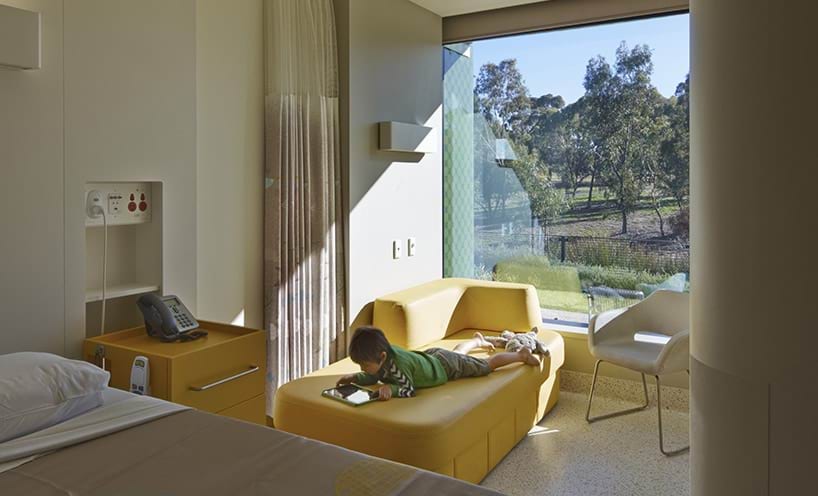
References
1 Rawsthorn A 2009, ‘Defining good or bad design’, The New York Times, 31 January, https://dealbook.nytimes.com/2009/01/31/defining-good-or-bad-design/
2 Commission for Architecture and the Built Environment 2002, The value of good design, CABE, London.
3 National Audit Office 2004, Getting value for money from construction projects through design.
4 MUF Architecture cited in Commission for Architecture and the Built Environment 2003, Radical improvements in hospital design: healthy hospitals campaign report, CABE, London.
5 Ulrich RS, Zimring C, Joseph A, Quan X and Choudhary R 2004, The role of the physical environment in the hospital of the 21st century: a once-in-a-lifetime opportunity, Center for Health Design, Concord CA.
6 Ibid.; Sadler BL, Leonard BL, Guenther R, Hamilton DK, Hessler FA, Merrit C and Parker D 2011, ‘Fable Hospital 2.0: the business case for building better health care facilities’, Good health care by design, vol. 41, no. 1, pp. 13–23; Ulrich RS, Zimring C, Zhu X, DuBose J, Seo HB, Choi YS, Quan X and Joseph A 2008, ‘A review of the research literature on evidence-based healthcare design,’ Health Environments Research and Design Journal, vol. 1, no. 3.
7 Ulrich RS et al. 2004, op. cit.; Sadler BL et al. 2011, op. cit.
8 CAB/ICM 2003, ‘Attitudes towards hospitals’, cited in CABE, Buildings and spaces: why design matters and CABE, Radical improvements in hospital design.
9 Ulrich RS et al. 2004, op. cit.
10 Sadler BL et al. 2011, op. cit.
11 Ulrich RS et al. 2004, op. cit.
12 Sadler BL et al. 2011, op. cit.
13 Ibid.
14 Lawson B, Phiri M and Wells-Thorpe J 2003, ‘The architectural healthcare environment and its effects on patient health outcomes: a report on an NHS Estates Funded Research Project’. Note: This research did not identify or quantify specific design variables; Lawson B 2002, ‘Healing architecture’, The Architectural Review, vol. 211, no. 1261, p. 72–75.
15 Ibid.
16 Lawson B, Phiri M and Wells-Thorpe J 2003, op. cit.
17 Ibid.
18 Ampt A et al. 2007, ‘A comparison of self-reported and observational work sampling techniques for measuring time in nursing tasks’, Journal of Health Services Research and Policy, vol. 12, no. 1, pp. 18–24; Joseph A 2006, ‘The role of the physical and social environment in promoting health, safety and effectiveness in healthcare workplace’, issue paper no. 3, Centre for Health Design.
19 PricewaterhouseCoopers with the University of Sheffield and Queen Margaret University College Edinburgh 2004, The role of hospital design in the recruitment, retention and performance of NHS nurses in England.
20 Ibid.
21 Burgio L, Engel A, Hawkins K, McCorick and Scheve A 1990, ‘A descriptive analysis of nursing staff behaviors in a teaching nursing home: differences among NAs, LPNs and RNs’, The Gerontologist, vol. 30, pp. 107–12, cited in Joseph A 2006, op. cit.
22 Ulrich RS et al. 2004, op. cit.
23 Ibid.
24 Ibid.
25 Ulrich RS 1984, ‘View through a window may influence recovery from surgery’, Science, New Series, vol. 224, no. 4647, pp. 420–21.
26 Ulrich RS et al. 2004, op. cit.
27 Ulrich RS 1984, op. cit.
28 Ibid.
29 Cooper-Marcus C and Barnes M 1995, Gardens in healthcare facilities: uses, therapeutic benefits, and design recommendations, Center for Health Design, Martinez, CA,
30 Whitehouse S, Varni JW, Seid M, Cooper-Marcus C, Ensberg MJ, Jacobs JR et al. 2001, ‘Evaluating a children’s hospital garden environment: utilization and consumer satisfaction’, Journal of Environmental Psychology, vol. 21, no. 3, pp. 301–14.
31 Cooper-Marcus C and Barnes M 1995, op. cit.
32 Beauchemin K and Hays P 1996, ‘Sunny hospital rooms expedite recovery from severe and refractory depressions’, Journal of Affective Disorders, vol. 40, pp. 49–51; Beauchemin K and Hays P 1998, ‘Dying in the dark: sunshine, gender and outcomes in myocardial infarction’, Journal of the Royal Society of Medicine, vol. 91, pp. 352–54.
33 Beauchemin K and Hays P 1996, op. cit.
34 Walch JM et al. 2005, ‘The effect of sunlight on postoperative analgesic medication use: a prospective study of patients undergoing spinal surgery’, Psychosomatic Medicine, vol. 67, no. 1, pp. 156–63.
35 Ibid.
36 Ulrich RS et al. 2004, op. cit.
37 Ibid.
38 Ibid.
39 Teltsch DY et al. 2011, ‘Infection acquisition following intensive care unit room privatization’, Arc Intern Med, vol. 171, no. 1.
40 Yamaguchi Y 2015, ‘Better healing from better hospital design’, Harvard Business Review, 5 October, https:// hbr.org/2015/10/better-healing-from-better-hospitaldesign
41 Ibid.
42 Ibid.
43 Ibid.
44 Ibid.
45 Ulrich RS et al. 2004, op. cit.
46 Guenther R and Vittori G 2013, Sustainable healthcare architecture, John Wiley and Sons, New Jersey.
47 Ibid.
48 Ibid.
49 Ibid.
50 Ibid.
51 Ibid.
52 Ibid.
53 Ibid.
54 Ibid.
55 Bates Smart nd, ‘The Royal Children’s Hospital Architecture’, https://www.batessmart.com/bates-smart/projects/sectors/health/the-new-…
56 Ibid.
57 Guenther R and Vittori G 2013, op. cit.
58 Ibid.
59 Ibid.
60 Ibid.
61 Ibid.
62 Ibid.
Updated
